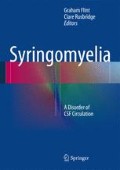Abstract
Syringomyelia and its underlying pathology combine to produce a variety of neurological symptoms. This chapter reviews the clinical features of Chiari malformations and those caused by the syrinx itself. Non-specific symptoms are also considered. The differential diagnosis of both Chiari headaches and syringomyelia myelopathy is discussed. Finally, the natural history and progression of syringomyelia is briefly reviewed.
Access this chapter
Tax calculation will be finalised at checkout
Purchases are for personal use only
References
Barnett HJM (1973) Syringomyelia consequent on minor to moderate trauma, chapter 13. In: Barnett HJM, Foster JB, Hudgson P (eds) Syringomyelia. WB Saunders, London
Barnett HJM, Jousse AT (1973) Syringomyelia as a late sequel to traumatic paraplegia and quadriplegia – clinical features, chapter 10. In: Barnett HJM, Foster JB, Hudgson P (eds) Syringomyelia. WB Saunders, London
Batzdorf U, Khoo LT, McArthur DL (2007) Observations on spine deformity and syringomyelia. Neurosurgery 61:370–378
Caldemeyer KS, Boaz JC, Wappner RS et al (1995) Chiari I malformation: association with hypophosphatemic rickets and MR imaging appearance. Radiology 195:733–738
Elisevich K, Fontaine S, Bertrand G (1987) Syringomyelia as a complication of Paget’s disease. J Neurosurg 66:611–613
Foster JB (1991) Neurology of syringomyelia, chapter 5. In: Batzdorf U (ed) Syringomyelia, current concepts in diagnosis and treatment. Williams and Wilkins, Baltimore
Friede RL, Roessmann U (1976) Chronic tonsillar herniation. Acta Neuropathol 34:219–235
Gowers WR (1886) A manual of diseases of the nervous system, vol 1. Churchill, London, pp 433–443
Heiss JD, Snyder K, Peterson MM et al (2012) Pathophysiology of primary spinal syringomyelia. J Neurosurg Spine 17:367–380
Hoffman HJ, Tucker WS (1976) Cephalocranial disproportion. A complication of the treatment of hydrocephalus in children. Childs Brain 2:167–176
Holly LT, Batzdorf U (2002) Slitlike syrinx cavities: a persistent central canal. J Neurosurg (Spine 1) 97:161–165
Holly LT, Batzdorf U (2006) Syringomyelia associated with intradural arachnoid cysts. J Neurosurg Spine 5:111–116
Holly LT, Johnson JP, Masciopinto JE et al (2000) Treatment of posttraumatic syringomyelia with extradural decompressive surgery. Neurosurg Focus 8(3):1–6
Honan WP, Williams B (1993) Sensory loss in syringomyelia: not necessarily dissociated. J R Soc Med 86:519–520
Jonesco-Sisesti N (1986) Syringobulbia. In: Ross RT (ed) A contribution to the pathophysiology of the brainstem. Praeger Publishers, New York
Kerr FWL (1961) A mechanism to account for frontal headache in cases of posterior-fossa tumours. J Neurosurg 18:605–609
Kumar A, Patni AH, Charbel F (2002) The Chiari malformation and the neurotologist. Otol Neurotol 23:727–735
LaHaye PA, Batzdorf U (1988) Posttraumatic syringomyelia. West J Med 148:657–663
Milhorat TH, Mu HTM, LaMotte CC et al (1996) Distribution of substance P in the spinal cord of patients with syringomyelia. J Neurosurg 84:992–998
Milhorat TH, Chou MW, Trinidad EM et al (1999) Chiari I malformation redefined: clinical and radiographic findings for 364 symptomatic patients. Neurosurgery 44:1005–1017
Mueller DM, Oró JJ (2004) Prospective analysis of presenting symptoms among 265 patients with radiographic evidence of Chiari malformation type I with or without syringomyelia. J Am Acad Nurse Pract 16:134–138
Muhonen MG, Menezes AH, Sawin PD et al (1992) Scoliosis in pediatric Chiari malformations without myelodysplasia. J Neurosurg 77:69–77
Rekate HL (2010) Box: Pseudotumor and obesity, in Hayhurst C, Rowlands A, Rowe F. Idiopathic intracranial hypertension, chapter 19. In: Mallucci C, Sgouros S (eds) Cerebrospinal fluid disorders. Informa Healthcare, New York, pp 360–367
Ryken TC, Menezes AH (1994) Cervicomedullary compression in achondroplasia. J Neurosurg 81:43–48
Schmidek HH (1977) Neurological and neurosurgical sequelae of Paget’s disease of bone. Clin Orthop 127:70–77
Sperling NM, Franco RA, Milhorat TH (2001) Otologic manifestations of Chiari I malformation. Otol Neurotol 22(5):678–681
Tabor EN, Batzdorf U (1996) Thoracic spinal pantopaque cyst and associated syrinx resulting in progressive spastic paraparesis: case report. Neurosurgery 39:1040–1042
Watson NF, Buchwald D, Goldberg J et al (2011) Is Chiari I malformation associated with fibromyalgia? Neurosurgery 68:443–449
Weig SG, Buckthal PE, Choi SK et al (1991) Recurrent syncope as the presenting symptom of Arnold-Chiari malformation. Neurology 41:1673–1674
Welch K, Shillito J, Strand R et al (1981) Chiari I “malformation” – an acquired disorder? J Neurosurg 55:604–609
Williams B (1981) Chronic herniation of the hindbrain. Ann R Coll Surg Engl 63(1):9–17
Williams B (1991) Pathogenesis of syringomyelia, chapter 4. In: Batzdorf U (ed) Syringomyelia: current concepts in diagnosis and treatment. Wiliams & Wilkins, Baltimore, pp 59–90
Yasui K, Hashizume Y, Yoshida M et al (1999) Age-related morphologic changes in the central canal of the human spinal cord. Acta Neuropathol (Berl) 97:253–259
Author information
Authors and Affiliations
Corresponding author
Editor information
Editors and Affiliations
Rights and permissions
Copyright information
© 2014 Springer-Verlag Berlin Heidelberg
About this chapter
Cite this chapter
Batzdorf, U. (2014). Clinical Presentation. In: Flint, G., Rusbridge, C. (eds) Syringomyelia. Springer, Berlin, Heidelberg. https://doi.org/10.1007/978-3-642-13706-8_8
Download citation
DOI: https://doi.org/10.1007/978-3-642-13706-8_8
Published:
Publisher Name: Springer, Berlin, Heidelberg
Print ISBN: 978-3-540-72484-1
Online ISBN: 978-3-642-13706-8
eBook Packages: MedicineMedicine (R0)

